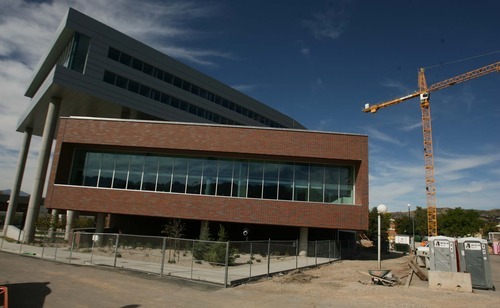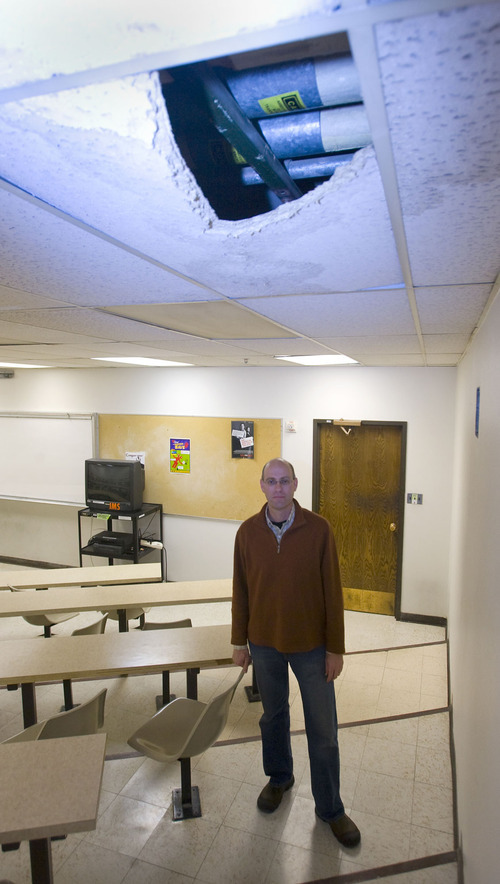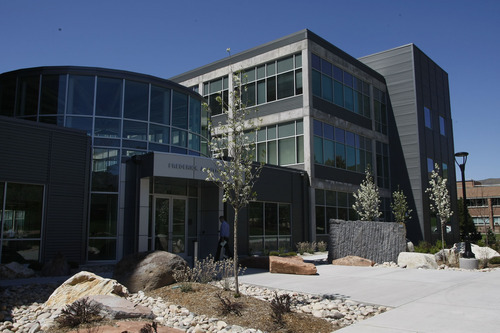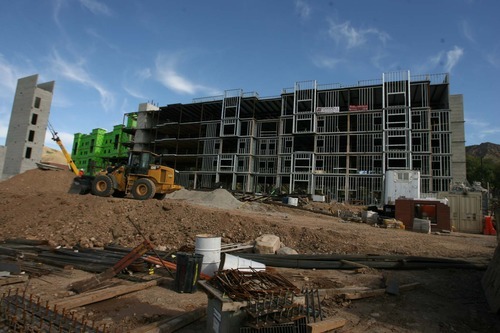This is an archived article that was published on sltrib.com in 2011, and information in the article may be outdated. It is provided only for personal research purposes and may not be reprinted.
The University of Utah's Frederick Albert Sutton geology building, completed in 2009 with donated money, replaced two old buildings with an architecturally striking showcase of energy efficiency. Gov. Gary Herbert unveiled his strategic energy plan in Sutton's fossil-adorned lobby, the first new-construction academic structure in Utah to achieve LEED Gold certification.
The building's energy-saving features cost donors more money up-front, but will reduce utility costs over the long haul, U. officials say.
Now, the 91,000-square-foot building has been called out for a much different reason. A new audit scolds higher education officials for tapping state funds to operate and maintain buildings financed without state money.
In a recent legislative audit, Sutton tops a list of 23 recently completed campus buildings across Utah that are ineligible for state operation and maintenance (O&M) funds, but probably are receiving them anyway. There's no way to know for sure because of inadequate documentation, according to auditor Kade Minchey. Together, these buildings could be sucking $4.3 million annually from the $133 million lawmakers appropriate for keeping the lights on and paying the janitors at hundreds of college buildings.
"We believe it is critical that buildings have maintenance and improvement funding identified before construction begins. Without a plan in place it appears that buildings are simply added to the existing O&M budget. This can bring down the maintenance of all buildings and either shorten lives of buildings or accelerate the need for costly repairs," Minchey told the Legislative Audit Committee last month.
The audit recommends schools use money from research grant-making agencies and building revenues, such as ticket sales and use fees, to pay for upkeep. While education leaders agree that "auxiliary" revenue-generating buildings should cover their own O&M, they say it is unreasonable to expect donors to pay to maintain buildings that are core to schools' research and educational missions.
"The focus should be on the use of the building, not the source of funds for [construction of] the building," said David Buhler, associate commissioner of higher education, about determining who should pay for O&M.
Lawmakers stress they appreciate universities' efforts to leverage nonstate sources of money, but note that construction accounts for only one-third of the cost of owning a building. In other words, the cost of running the building over the course of its life is double the cost of construction.
"Our first priority is to fund the state buildings that fill critical needs and once we do, we are obligated to O&M," said Rep. Gage Froerer, R-Huntsville, co-chairman of the Infrastructure and General Government Appropriations Subcommittee. But the Legislature is in no financial position to promise operating funds for buildings that someone else finances.
This funding issue will only become more acute as buildings age and schools build new ones. The U. is in the midst of a $1 billion building binge, fueled largely by outside money.
Meanwhile, the Legislature has been slow to increase O&M funding for existing buildings. The U.'s facilities chief, Michael Perez, has cautioned lawmakers that the state's failure to adjust O&M costs for inflation could cost taxpayers dearly.
"As buildings age, the various needs to maintain the facility increase in cost — the piping, equipment, roofing materials, etc. — while our agencies do not get increases for those types of costs," Perez said at a 2009 committee hearing. "If you look at what we spend on O&M per square foot, we are woefully behind standards."
Now a vicious cycle has begun, in which inadequate funding is increasing deferred maintenance, which in turn ratchets up funding needs, he warned. The U.'s century-old Life Sciences building, whose leaky hot-water pipes wreck ceilings and floors and disrupt classes and research, illustrates the high cost of putting off maintenance.
While old buildings aren't being renovated, the U. has enjoyed success soliciting money from foundations, corporations and wealthy Utahns to pay for new and replacement buildings. But legislative policy bars schools from getting operations funding for such buildings at the time they are approved.
The U. is specifically prohibited from seeking state money to operate the 41,000-square-foot addition to its chemistry building, which broke ground last month. The Salt Lake City family associated with Thatcher Chemical is paying much of the $22 million price tag.
Private donors are paying for several other mission-central buildings now under construction, such as the Honors College, the Sorenson Arts and Education Building, the School of Business replacement and College of Pharmacy addition. These projects have massive O&M projections, but the U. cannot even ask the state for funding until after they are in use, according to Perez.
"The University of Utah is very fortunate to have individuals and organizations whose gifts allow us to build buildings for which there aren't state funds to do it. This expands both research capacity and teaching capacity," said Fred Esplin, the U.'s vice president for institutional advancement. "The donors are doing their part. They would hope the state recognizes this is a wonderful partnership and that the cost of supporting the educational purposes is something the state could participate in."
Privately funding O&M would require an endowment, an investment fund whose proceeds would be tapped to cover such costs. Typical payouts are 4 percent annually, with the rest getting plowed back into the fund, according to Esplin. So an endowment big enough to cover Sutton's operation would be $12 million.
"That was the size of the naming gift. Unfortunately, it is not possible to get that amount in private gifts," Esplin said. The geology building is named for Utah geologist and 1917 U. graduate Frederick Albert Sutton, whose family covered nearly half of the building's $25 million cost.
"This is a building where we did it right," said Marjorie Chan, the geology department's former chairwoman. "This has really raised our visibility on campus. This is a building that inspires students and gets people excited about Earth sciences. It is a strong recruiting tool and attracted faculty that we wouldn't have been able to attract. It has added value to the university and its educational mission."
The high cost of college buildings
State-owned college and university buildings number 1,214 or 30.5 million square feet. The state budgeted $133 million for operation and maintenance last fiscal year, but auditors complain there is no way of determining whether this money was spent on buildings paid for with state money. Here is a list of Utah universities and colleges and their O&M appropriations for fiscal year 2010-11, and what that represents as a percentage of the institution's general appropriation.
U. of U. $46.5 mil. 13%
USU $25.3 mil. 14%
Weber $11.6 mil. 10%
SUU $8.2 mil. 14%
UVU $13.1 mil. 9%
Snow $5.3 mil. 21%
Dixie $5 mil. 15%
CEU $1.5 mil. 10%
SLCC $16.5 mil. 16%
Total $133.1 mil. 13%
Source: Office of the Utah Legislative Auditor General —
O&M outlaws
Legislative auditors identified 23 new campus buildings for which lawmakers have not authorized operating and maintenance funding. Together, these buildings cost $4.3 million annually to operate. Here is the list of those buildings, and their estimated annual O&M costs. Many were built entirely with donated money.
University of Utah
Sutton Geology • $480,600
Lassonde Entrepreneurial Center • $58,600
Red Butte Arboretum Visitors' Center • $6,800
Moran Eye Center • $235,000
Meldrum engineering • $76,400
Eyring Chemistry addition • $344,900
Utah State University
Uintah Basin Entrepreneurship/Energy • $551,000
Agriculture Equine Education Center • $396,500
Tooele Regional Campus • $140,200
Early Childhood Development Building • $496,200
Laub Athletic/Academic Building (North End Zone) • $266,700
Botanical Center Classroom Building • $58,300
Regional Campus/Distance Education • $291,000
Art Barn • $35,000
Athletics Practice and Competition Center • $61,000
Weber State University
Hurst Lifelong Learning Center • $210,500
Dixie State College
Training Facility • $40,600
Utah Valley University
Murdock Property • $129,200
Noorda Children's Theater Addition • $56,200
Intramural Fields • $51,900
Economic Development Building • $67,400
Athletic Track • $50,000
Southern Utah University
Southern Utah Museum of Arts • $238,000
Source • Office of the Utah Legislative Auditor General











